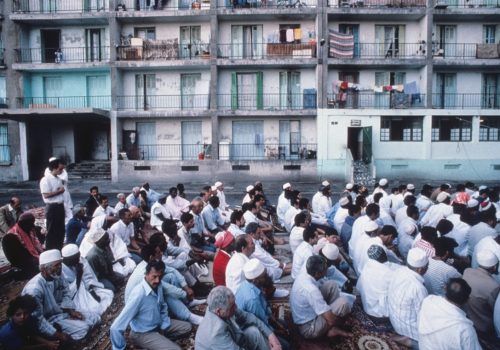Yes, Marseille can be written in Arabic letters and the Michel Setboun’s series Les banlieues de l’Islam, shock and disturb. Marseille and Islam. Finally, France and Isalm. “this nagging question of immigration, of integration.” Muslims who set out their prayer mats on the street. Photos that reminded me most recently of the Goutte d’Or in Paris. Michel Setboun is aware of it, “You can make these images say what you want. They are ambiguous, thanks to all the propaganda. Since then, they’ve often been taken up by the extreme right… The problem of the relationship between photography and the truth. A reason to show them? So that these things be known. They must be said”. And said they are.
A Lot is said about urban renewal in Marseille. The deprived estates, in particular. From far and near, when you’re there, they fascinate you. Architecturally imposing, they overlook the city much more than the Holy Mother. Returning from the Calanques, you can’t miss them. You want to go there, to see what happens there and often you avoid it. They prefer the old port, the Cours Julien or the Panier. And yet, there are lots of stories to hear, faces to meet, meals to be shared. For nearly half a century that’s been the way in the Belleville estate, to mention just one. Tunisian Jews, Algerian pieds noirs, people from Maghreb and finally, a population mainly from the Comoros followed one another into this vast group of more than five thousand inhabitants.
It’s tempting just to choose the images from the series that can shock. Those that make you talk about them and take a like or a dislike. That would be to forget Michel Setboun’s work. Through the looks, the attitudes, and the body positions, the photographer has succeeded in capturing the good-natured atmosphere of the neighbourhoods as well as their extreme poverty. The housing estates and their daily lives. Marseille and its diversity. You almost think of Algiers, Tunis, Palermo, Beirut, and Moroni.Marseille is certainly the heart of this Mediterranean that MUCEM has chosen to address. For years, the city has been a polyglot one and has welcomed refugees from all over the world. In this series produced between 1988 and 1990, portraits, families and scenes of life follow one another. If Michel had first erected his set in the Clos du Rose and Bellevue estates, it was to show life there. In Arabic, life is Hayat. You often hear this word side by side with the first name of someone or something you love. Hayati Marseille.
Sabyl Ghoussoub
Sabyl Ghoussoub is a journalist and photographer and from 2011 to 2015 was Director of the Lebanese Film Festival in Beirut..
















